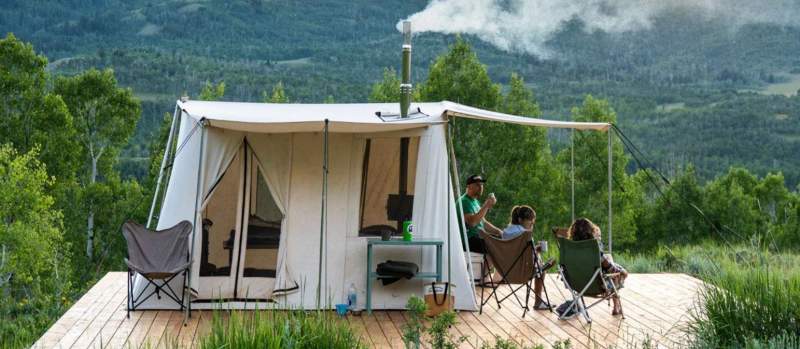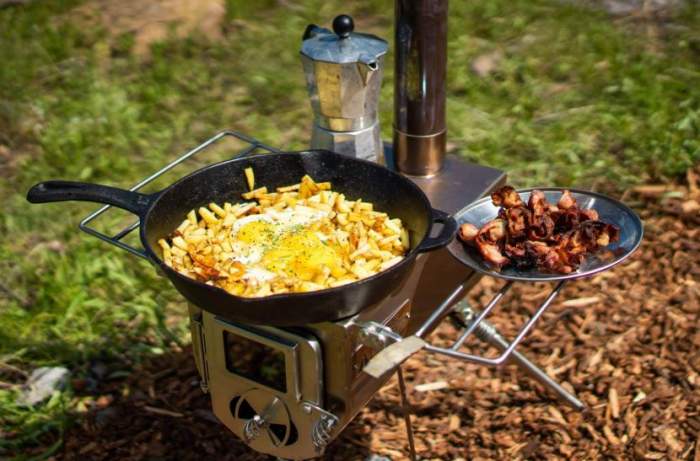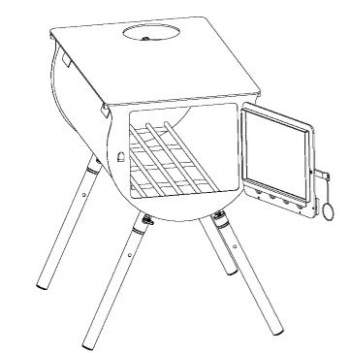Here are a few tips on how to choose a camping tent stove for wood burning and which features you might expect from such a stove suitable for larger camping tents used by hunters, adventurers, and families.

Why this text
There are several tents in my list of cold weather tents for camping that have an integrated stove pipe jack, so they are designed to be heated. In fact, some of them have two of them, and some even have a wood-burning stove included in the package; you can see one nice example here.
So if you decide to buy such a winter tent, you will probably use a wood stove in it, and here are a few things to consider.
Camping tent stoves guide
What type of tent to use
• As I mentioned above, some of the winter tents are designed for a wood stove. But if they do not have a pipe jack, you can make it yourself, it is perfectly doable. See an example here together with instructions on how to add it to your tent. In any case, this is an essential element the tent needs, built to protect the tent from the hot stove pipe and built from fire-resistant materials.
But if you decide to build in a pipe jack, you certainly would not go for a tent with a mesh ceiling. This would be pointless. So use some of those enclosed tents that can preserve the heat.
• Make sure also to have a good ventilation when needed, to reduce condensation and to release potentially harmful gasses out of the tent. So a good tent should have flor vents and high vents as well, or its walls should be breathable like in canvas camping tents or built from a special material. Some stoves manufacturers recommend having some 20 square inches (130 cm²) opening on the tent for ventilation at all times.
• Some of the canvas tents described here in the site have an option to zip out the floor, so you might want to do this in the area under the stove, but this is not necessary, you can put some fire-retardant material under the stove and remain safe from crawling insects.
• Bear in mind the size of the tent from one side and the capacity of the stove from the other. Having a small and portable structure as the one shown in the picture below with the Winnerwell Woodlander Medium Tent Stove, is surely great but the stove should be able to heat the tent’s space.

Stove dampers

It is important to have a stove with features that allow you to control the emitted heat. In such a way you will not lose the heat too much, and you will be able to adjust the fire properly for the tent’s size, and also to keep it burning longer.
So a stove should have a damper on the front of the stove, see below an example from the Guide Gear Wood Stove, and yet another on the pipe. The front damper regulates the amount of air and this means the burning speed.
The damper on the stovepipe (shown in the picture right) regulates how much heat escapes, so if you close it partly the heat will be reflected back, otherwise it will be sucked out of the tent. Closing it partly might increase the burning temperature in general, and also more heat will then be conducted into the tent. This element can make the stove up to 15% more efficient, this means reducing the amount of wood for the given percentage.

Stove racks
Some wood-burning stoves have racks that you attach on the side. One such example is this Camp Chef Alpine Wood Stove. This is very useful because the stove surface is usually small and you need space to put the cooking pots aside while preparing the food, or just to keep the food warm in the pot, or to dry your wet gloves and socks. This ultralight Kcelarec Camping Titanium Tent Stove has one rack and a wood drying basket.

Spark screen or spark arrestor
In some wood stoves, the spark screen looks like a wire net which you fold over the top of the pipe. It will catch sparks that might escape and damage the tent’s roof. If you do not have one in the package, you can make it yourself.
But note that some wood stoves come with pipes that have such a design integrated on the top of the pipe, see the pictures here where you have the Guide Gear Outdoor Wood Stove. One different design used in the Winnerwell Nomad Medium Tent Stove is shown in the picture below.

Observe that in some cases, dependent on the stove jack diameter, some pipe sections and the spark arrestor, in particular, might need to be installed from the outside. This may be tricky if the tent is tall.
Wood grate (ash rack)
This is a structure inside the stove see the picture, normally removable, which keeps the wood off the bottom of the stove. In this way, air can circulate underneath it and the wood will burn better.

Window
There are some great models with a window on the door like the Nomad Medium Stove, and some even have a side window as in the case of the Nomad View Large Stove.
Water tank
Some wood stoves come with a water tank, but you can also order it separately. See one example below from the Timberline Stove Package, and the same is with the Cylinder Stoves Outfitter Wood Stove Package.

Camping stove oven
Yes, you are reading correctly. You can have this luxury in the camp. This is a box that fits on the stove pipe above the stove. The picture below shows the Winnerwell Pipe Oven. It is heated by the smoke and heat coming from below and circulating around it before exiting out. As you can imagine, this will add some extra heat in the tent as well.

They have yet another different design with the oven that you put on the cooktop, you can see it in my text about the Winnerwell Nomad Medium Tent Stove.
Some extras
• I have seen some suggesting putting rocks in the stove or on it, to retain heat. I am convinced this is a very bad idea. Have seen some people writing about rocks exploding in such situations. I have not experienced this myself (I would not use rocks for such a purpose) but as a physicist by profession, I guess this is dependent on the type of the rock. In the case of cavities in the rock, gasses will be released and trapped and the pressure may grow leading to rock cracking or perhaps even exploding.
On the other hand, I grew up in a rural environment where people were making lime for home use by backing limestone at high temperatures. Such a backed rock becomes porous and very light, and in contact with water, it releases lots of heat, it disintegrates instantly and becomes a white boiling matter similar to yogurt. So imagine how hazardous this all can be in a tent.
• If your tent is already with a pipe jack, then you do not have much choice about the position of the pipe. But you can still rotate the stove so that it does not come close to the walls. The best position is in the center of the tent, so all areas of the tent will be equally heated.
• Some manufacturers recommend all combustible materials to be at least 3 feet (91 cm) away from the stove. So the closer to the center of the tent the better.
Thank you for reading. Please check my texts about the Camp Chef Alpine, Winnerwell Nomad, and Winnerwell Woodlander stoves. You might want also to read about BTU for tent heaters, and our separate text on heating a camping tent.
I might have missed something important to add here, so please let me know if you notice it, there is a comment box below. This text will be updated from time to time so bookmark it and do visit this page again.
Would you recommend multiple heaters or larger single heater for large cabin style tents like an oztrail chateau 12, where there are 3 connected sections, with the middle section of nearly the same size dimensions as the sides.
Most likely you will have better heating with several heaters, but I guess this would be less economical. It is hard to say really.
I am interested in learning about cheap powered electrical generators I’m not sure if this is some kind of induction process or how the electricity is generated but I noticed that you did not put it in this literature so I was wondering if you could do a piece on it
Hi Bradley, I assume your question is in the context of tent heating, if so I might think about adding a text on this. I am a physicist by profession so this is an interesting topic for me.
I’m planning on going on a winter camp, but I don’t want to be too cold. It makes sense that getting the right kind of stove would be beneficial! It would be so nice to be able to stay warm at night.
Hi Braden, yes you are completely right. Just take the right tent with you, it should be an enclosed design but with enough options for ventilation.
Is an eskimo BRAND tent a safe tent to put a stove in? THANK YOU
Hi Teresa, I know for sure that some people use a stove inside. But it is not built for a stove. Is it safe? I also know some people claim that you should never use a stove in a tent, but I do not share this opinion. I have a separate text on this issue, have a look here.